Jewish religious movements
| Part of a series on |
| Judaism |
|---|
   |
| Part of a series on |
| Jews and Judaism |
|---|
Jewish religious movements, sometimes called "denominations", include diverse groups within Judaism which have developed among Jews from ancient times. Today in the west, the most prominent divisions are between traditionalist Orthodox movements (including Haredi ultratraditionalist and Modern Orthodox branches) and modernist movements such as Reform Judaism originating in late 18th century Europe, Conservative (Masorti) originating in 19th century Europe, and other smaller ones,[1] including the Reconstructionst and Renewal movements which emerged later in the 20th century in the United States.
In Israel, variation is moderately similar,[2][3][4][5] differing from the west in having roots in the Old Yishuv and pre-to-early-state Yemenite infusion, among other influences. For statistical and practical purposes, the distinctions there are based upon a person's attitude to religion. Most Jewish Israelis classify themselves as "secular" (hiloni), "traditional" (masortim), "religious" (dati) or ultra-religious (haredi).[6][5]
The western and Israeli movements differ in their views on various issues (as do those of other Jewish communities). These issues include the level of observance, the methodology for interpreting and understanding Jewish law, biblical authorship, textual criticism, and the nature or role of the messiah (or messianic age). Across these movements, there are marked differences in liturgy, especially in the language in which services are conducted, with the more traditional movements emphasizing Hebrew. The sharpest theological division occurs between traditional Orthodox and the greater number of non-Orthodox Jews adhering to other movements (or to none), such that the non-Orthodox are sometimes referred to collectively as the "liberal" or "progressive streams".
Other divisions of Judaism in the world reflect being more ethnically and geographically rooted, e.g., Beta Israel (Ethiopian Jews), and Bene Israel (among the ancient Jewish communities of India). Normatively, Judaism excludes from its composition certain groups that may name or consider themselves ethnic Jews but hold key beliefs in sharp contradiction, for example, modern or ancient Messianic Jews.
Terminology[edit]
Some Jews reject the term denomination as a label for different groups and ideologies within Judaism, arguing that the notion of denomination has a specifically Christian resonance that does not translate easily into the Jewish context. However, in recent years the American Jewish Year Book has adopted "denomination", as have many scholars and theologians.[7]
Commonly used terms are movements,[8][9][10][11][12][13][14][3][15][16][17][18] as well as denominations,[19][20][21][22][7][15][23][24] varieties,[1] traditions,[25] groupings,[17][26] streams,[27] branches,[28] sectors and sects (for some groups),[29][30] trends,[31] and such. Sometimes, as an option, only three main currents of Judaism (Orthodox, Conservative and Reform) are named traditions, and divisions within them are called movements.
The Jewish groups themselves reject characterization as sects. Sects are traditionally defined as religious subgroups that have broken off from the main body, and this separation usually becomes irreparable over time. Within Judaism, individuals and families often switch affiliation, and individuals are free to marry one another, although the major denominations disagree on who is a Jew. It is not unusual for clergy and Jewish educators trained in one of the liberal denominations to serve in another, and left with no choice, many small Jewish communities combine elements of several movements to achieve a viable level of membership.
Relationships between Jewish religious movements are varied; they are sometimes marked by interdenominational cooperation outside of the realm of halakha (Jewish law), such as the New York Board of Rabbis, and sometimes not. Some of the movements sometimes cooperate by uniting with one another in community federations and in campus organizations such as the Hillel Foundation. Jewish religious denominations are distinct from, but often linked to, Jewish ethnic divisions and Jewish political movements.
Sects in the Second Temple period[edit]
Prior to the destruction of the Second Temple in 70 CE, Jews of the Roman province of Judaea were divided into several movements, sometimes warring among themselves: Pharisees, Sadducees, Essenes, Zealots, and ultimately early Christians. Many historic sources such as Flavius Josephus, the New Testament and the recovered fragments of the Dead Sea Scrolls, attest to the divisions among Jews at this time. Rabbinical writings from later periods, including the Talmud, further attest these ancient schisms.[32][33]
The main internal struggles during this era were between the Pharisees and the Sadducees, as well as the early Christians, and also the Essenes and Zealots. The Pharisees wanted to maintain the authority and traditions of classical Torah teachings and began the early teachings of the Mishna, maintaining the authority of the Sanhedrin, the supreme Jewish court. According to Josephus, the Sadducees differed from the Pharisees on a number of doctrinal grounds, notably rejecting ideas of life after death. They appear to have dominated the aristocracy and the temple, but their influence over the wider Jewish population was limited. The Essenes preached an ascetic way of life. The Zealots advocated armed rebellion against any foreign power such as Rome. All were at violent logger-heads with each other, leading to the confusion and disunity that ended with the destruction of the Second Temple and the sacking of Jerusalem by Rome. The Jewish Christians were the original Jewish followers of Jesus. The radical interpretation of Moses' Law by Jesus' disciples and their belief he is the Son of God, along with the development of the New Testament, ensured that Christianity and Judaism would become distinctively different religions.[32][33]
Rabbinic Judaism[edit]
Most streams of modern Judaism developed from the Pharisaic movement, which became known as Rabbinic Judaism (in Hebrew Yahadut Rabanit — יהדות רבנית) with the compilation of the Oral Torah into the Mishna. After the Bar Kokhba revolt and the destruction of the Second Temple the other movements disappeared from the historical record, yet the Sadducees probably kept on existing in a non-organized form for at least several more decades.[34][32][35]
Non-Rabbinic Judaism[edit]
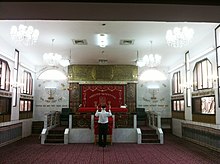
Non-Rabbinic Judaism—Sadducees, Nazarenes, Karaite Judaism, and Haymanot—contrasts with Rabbinic Judaism and does not recognize the Oral Torah as a divine authority nor the rabbinic procedures used to interpret Jewish scripture.[36]
Karaite Judaism[edit]
The tradition of the Qara'im survives in Karaite Judaism, started in the early 9th century when non-rabbinic sages like Benjamin Nahawandi and their followers took the rejection of the Oral Torah by Anan ben David to the new level of seeking the plain meaning of the Tanakh's text. Karaite Jews accept only the Tanakh as divinely inspired, not recognizing the authority that Rabbinites ascribe to basic rabbinic works like the Talmud and the Midrashim.[37][38]
Ethno-cultural divisions' movements[edit]
Although there are numerous Jewish ethnic communities, there are several that are large enough to be considered predominant. Generally, they do not constitute separate religious branches within Judaism, but rather separate cultural traditions (nuschaot) and rites of prayer (minhagim). Ashkenazi Jews compose about 75% of the world's Jewish population. Sephardi Jews and Mizrahi Jews compose the greatest part of the rest, with about 20% of the world's Jewish population. Israel has two Chief Rabbi—one for the Ashkenazic, another for the Sephardic with Mizrahi Jews.[39] The remaining 5% of Jews are divided among a wide array of small groups (such as various groups of African Jews, most prominently the Beta Israel from Ethiopia who follow the Haymanot branch of Judaism), some of which are nearing extinction as a result of assimilation and intermarriage into surrounding non-Jewish cultures or surrounding Jewish cultures. Additionally, special ethnoreligious divisions are also the Italian rite Jews and the Greek Romaniote Jews. Both groups are considered distinct from Ashkenazim and Sephardim.
The Enlightenment had a tremendous effect on Jewish identity and on ideas about the importance and role of Jewish observance.[40] Due to the geographical distribution and the geopolitical entities affected by the Enlightenment, this philosophical revolution essentially affected only the Ashkenazi community; however, because of the predominance of the Ashkenazi community in Israeli politics and in Jewish leadership worldwide, the effects have been significant for all Jews.[40]
Sephardic and Mizrahi Judaism[edit]

Sephardic Judaism is the practice of Judaism as observed by the Sephardim (Iberian, Spanish-Portuguese Jews). The Mizrahi Jews (including Maghrebi) are all Oriental Jewry. Some definitions of "Sephardic" also include Mizrahi, many of whom follow the same traditions of worship but have different ethno-cultural traditions. So far as it is peculiar to themselves and not shared with other Jewish groups such as the Ashkenazim (German rite).[41][42][43]
Sephardim are primarily the descendants of Jews from the Iberian Peninsula, such as most Jews from France and the Netherlands. They may be divided into the families that left in the Expulsion of 1492 and those that remained as crypto-Jews, Marranos and those who left in the following few centuries. In religious parlance, and by many in modern Israel, the term is used in a broader sense to include all Jews of Ottoman or other Asian or African backgrounds (Mizrahi Jews), whether or not they have any historic link to Spain, although some prefer to distinguish between Sephardim proper and Mizraḥi Jews.
Sephardic and Mizrachi Jewish synagogues are generally considered Orthodox or Sephardic Haredim by non-Sephardic Jews, and are primarily run according to the Orthodox tradition, even though many of the congregants may not keep a level of observance on par with traditional Orthodox belief. For example, many congregants will drive to the synagogue on the Shabbat, in violation of halakha, while discreetly entering the synagogue so as not to offend more observant congregants. However, not all Sephardim are Orthodox; among the pioneers of the Reform Judaism movement in the 1820s there was the Sephardic congregation Beth Elohim in Charleston, South Carolina.[44][45] A part of the European Sephardim were also linked with the Judaic modernization.[46]
Unlike the predominantly Ashkenazic Reform, and Reconstructionist denominations, Sephardic and Mizrahi Jews who are not observant generally believe that Orthodox Judaism's interpretation and legislation of halakha is appropriate, and true to the original philosophy of Judaism. That being said, Sephardic and Mizrachi rabbis tend to hold different, and generally more lenient, positions on halakha than their Ashkenazi counterparts, but since these positions are based on rulings of Talmudic scholars as well as well-documented traditions that can be linked back to well-known codifiers of Jewish law, Ashkenazic and Hasidic Rabbis do not believe that these positions are incorrect, but rather that they are the appropriate interpretation of halakha for Jews of Sephardic and Mizrachi descent.[41][43][47]

The Yemenite Jews—the Dor Daim and other movements—use a separate Baladi-rite. The Yemenite and the Aramaic speaking Kurdish Jews are the only communities who maintain the tradition of reading the Torah in the synagogue in both Hebrew and the Aramaic Targum ("translation"). Most non-Yemenite synagogues have a specified person called a Baal Koreh, who reads from the Torah scroll when congregants are called to the Torah scroll for an aliyah. In the Yemenite tradition, each person called to the Torah scroll for an aliyah reads for himself.[48]
The Shas, a religious political party in Israel, represents the interests of the Orthodox/Haredi Sephardim and Mizrahim.[49]
Italian and Romaniote Judaism[edit]
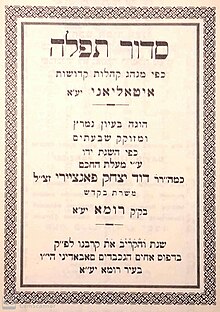
A relatively small but influential ethnoreligious group in the intellectual circles of Israel are Italian rite Jews (Italkim) who are neither Ashkenazi nor Sephardi. These are exclusively descendants of the ancient Roman Jewish community, not including later Ashkenazic and Sephardic migrants to Italy. They practice traditional Orthodox Judaism. The liturgy is served according to a special Italian Nusach (Nusach ʾItalqi, a.k.a. Minhag B'nei Romì) and it has similarities with the nusach of the Greek Romaniote Jews.
The Romaniote Jews or the Romaniotes (Romanyotim) native to the Eastern Mediterranean is the oldest Jewish community in Europe, whom name is refers to the Eastern Roman Empire. They are also distinct from the Ashkenazim and Sephardim. But, nowadays, few synagogues still use the Romaniote nusach and minhag.
Ashkenazic movements[edit]
Hasidic Judaism[edit]

Hasidic Judaism—a revivalist movement—was founded by Israel ben Eliezer (1700–1760), also known as the Baal Shem Tov, whose followers had previously called themselves Freylechn ("happy ones") and now they call themselves Hasidim ("pious, holy ones"). His charismatic disciples attracted many followers among Ashkenazi Jews, and they also established numerous Hasidic groups across Europe. The Baal Shem Tov came at a time when the Jewish masses of Eastern Europe were reeling from the bewilderment and disappointment which were engendered in them by the two notorious Jewish false messiahs, Sabbatai Zevi (1626–1676) and Jacob Frank (1726–1791), and their respective followers. Hasidic Judaism eventually became the way of life for many Jews in Eastern Europe. The Hasidim are organized into independent "courts" or dynasties, each dynasty is headed by its own hereditary spiritual leader-rebbe. Unlike other Ashkenazim, most Hasidim use some variation of Nusach Sefard, a blend of Ashkenazi and Sephardi liturgies, based on the innovations of the Kabbalist Isaac Luria. Neo-Hasidism is a term which refers to trends of interest in the teachings of Kabbalah and Hasidism which are expressed by members of other existing Jewish movements.[50][51][52][53][54]
Lithuanian (Lita'im)[edit]
In the late 18th century, there was a serious schism between Hasidic and non-Hasidic Jews. European traditionalist Jews who rejected the Hasidic movement were dubbed Mitnagdim ("opponents") by the followers of the Baal Shem Tov. Lithuania became the centre of this opposition under the leadership of Vilna Gaon (Elijah ben Solomon Zalman), which adopted the epithets Litvishe (Yiddish word), Litvaks (in Slavic) or Lita'im (in Hebrew) those epithets refer to Haredi Jews who are not Hasidim (and not Hardalim or Sephardic Haredim). Since then, all of the Hasidic Jewish groups have been theologically subsumed into mainstream Orthodox Judaism, particularly, Haredi Judaism, but cultural differences persist.[55][51][56][57][54][17][58] In the 19th century, the Lithuanian spirituality was mainly incorporated into the Musar movement.[59][60][61][62]
Post-Enlightenment movements[edit]
Late-18th-century Europe, and then the rest of the world, was swept by a group of intellectual, social and political movements that taken together were referred to as the Enlightenment. These movements promoted scientific thinking, free thought, and allowed people to question previously unshaken religious dogmas. The emancipation of the Jews in many European communities, and the Haskalah movement started by Moses Mendelssohn, brought the Enlightenment to the Jewish community.[40]
In response to the challenges of integrating Jewish life with Enlightenment values, German Jews in the early 19th century began to develop the concept of Reform Judaism, adapting Jewish practice to the new conditions of an increasingly urbanized and secular community. Staunch opponents of the Reform movement became known as Orthodox Jews. Later, members of the Reform movement who felt that it was moving away from tradition too quickly formed the Conservative movement.[63]
At the same time, the notion "traditional Judaism" includes the Orthodox with Conservative[17] or solely the Orthodox Jews[16] or exclusively pre-Hasidic pre-modern forms of Orthodoxy.[64]
Over time, three main movements emerged (Orthodox, Reform and Conservative Judaism).[17][16]
Orthodoxy[edit]
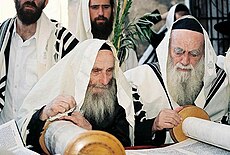
Orthodox Jews generally see themselves as practicing normative Judaism, rather than belonging to a particular movement. Within Orthodox Judaism, there is a spectrum of communities and practices, ranging from ultra-Orthodox Haredi Judaism and Jewish fundamentalism to Modern Orthodox Judaism (with Neo-Orthodoxy, Open Orthodoxy, and Religious Zionism). Orthodox Jews who opposed the Haskalah became known as Haredi Jews (Haredim), including Hardalim, Hasidim, Misnagdim (Lita'im), and Sephardim Haredim. Orthodox Jews who were sympathetic to the Haskalah formed what became known as modern/neo-Orthodox Jews.[65][11][66][67][31][68][30][69] The German rabbi Azriel Hildesheimer is regarded as a Modern Orthodoxy founder,[70][71] while the father of neo-Orthodoxy was German rabbi Samson Raphael Hirsch, who proclaimed principle Torah im Derech Eretz—the strict observance of the Jewish Law in an active social life—in 1851, he become the rabbi of first Orthodox separatist group from Reform community of Frankfurt am Main.[72][73] In addition, the "Centrist" Orthodoxy was represented by American rabbi Joseph B. Soloveitchik affiliated with the Orthodox Union.[74][71]
In Israel, Orthodox Judaism occupies a privileged position: solely an Orthodox rabbi may become the Chief rabbi and Chief military rabbi; and only Orthodox synagogues have the right to conduct Jewish marriages.[5][68]
Reform[edit]
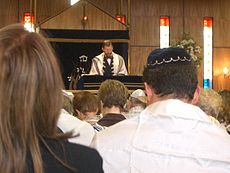
Reform Judaism, also known as Liberal (the "Liberal" label can refer only to the British branch)[28] or Progressive Judaism, originally began in Germany, the Netherlands and the United States c. 1820 as a reaction to modernity, stresses assimilation and integration with society and a personal interpretation of the Torah. The German rabbi and scholar Abraham Geiger with principles of Judaism as religion and not ethnicity, progressive revelation, historical-critical approach, the centrality of the Prophetic books, and superiority of ethical aspects to the ceremonial ones has become the main ideologist of the "Classical" Reform. Unlike traditional Judaism, the Reform rejects the concept of the Jews as the chosen people.[8][75][11][76][13][77][78][79][80][45] There are transformations from the purism of "Classical" European to the "New Reform" in America with reincorporation some traditional Jewish elements.[81][82]
In the United States, at the turn of the 20th and 21st centuries, the Reform movement became the first in terms of numbers, ahead of Conservative Judaism.[83][84] In contrast, Israeli Reform is smaller one.[2][3]
Conservative (Masorti)[edit]
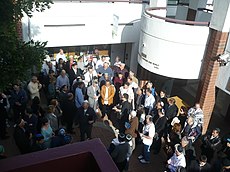

Conservative or Masorti Judaism, originated in Germany in the 19th century on the ideological foundation of the Historical School studies,[85] but became institutionalized in the United States, where it was to become the largest Jewish movement[16][18][86] (however, in 1990 Reform Judaism already outpaced Conservatism by 3 percent).[83] After the division between Reform and Orthodox Judaism, the Conservative movement tried to provide Jews seeking liberalization of Orthodox theology and practice, such as female rabbi ordination, with a more traditional and halakhically-based alternative to Reform Judaism. It has spread to Ashkenazi communities in Anglophone countries and Israel.[9][87][11][88][2][3][89][90][18]
Neolog Judaism, a movement in the Kingdom of Hungary and in its territories ceded in 1920, is similar to the more traditional branch of American Conservative Judaism.[91]
Communal Judaism (Ḥevrati)[edit]
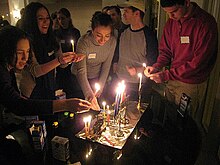
Communal Judaism, also referred to as יהדות חברתי (Yahadut Ḥevrati) in Hebrew, is a denomination that intertwines the ethnoreligious identity and indigenous tradition within the broader Jewish community. Unlike other movements which may emphasize theological nuances, Communal Judaism places a substantial focus on the social and communal aspects of Jewish life, alongside personal spiritual practices.
Practitioners are diverse, found globally with significant numbers in Israel and the United States, extending to European and Middle Eastern countries. This spread is reflective of the movement's inclusive approach to Jewish identity, welcoming those who align with its core values of maintaining communal traditions and customs without the stringent adherence to rabbinical interpretations that some other denominations might require.[92][93]
In terms of religious observance, adherents commonly engage in the lighting of Shabbat candles, recitation of Kiddush, and the enjoyment of communal meals replete with traditional zemirot. This practice is designed to foster a sense of community and spiritual reflection, particularly on Shabbat where the use of technology is often set aside to maintain a contemplative state.[94][95]
Dietary laws within Communal Judaism adhere to kashrut, the set of Jewish dietary laws, with a focus on traditional observance. This includes abstaining from pork and shellfish and not mixing meat with dairy products, as outlined in the Torah.[96]
The connection to Israel stands as a central tenet of Communal Judaism, emphasizing a deep ethnic heritage and historical relationship with the land. This connection is celebrated and remembered through the observance of holidays and commemorations that reflect on the Jewish people's historical experiences of dispersal and return.[97][98]
Spiritually, Communal Judaism advocates for the integration of tradition into daily life, upholding a heart-centered approach to religious practice. While individual prayer is encouraged, the emphasis is placed on communal worship and support, reflecting the movement's overarching commitment to a life lived in close connection with one's community and heritage.[92][93]
Migration[edit]
The particular forms which the denominations have taken on have been shaped by immigration of the Ashkenazi Jewish communities, once concentrated in eastern and central Europe, to western and mostly Anglophone countries (in particular, in North America). In the middle of the 20th century, the institutional division of North American Jewry between Reform, Conservative, and Orthodox movements still reflected immigrant origins. Reform Jews at that time were predominantly of German or western European origin, while both Conservative and Orthodox Judaism came primarily from eastern European countries.[99]
Zionists (Datim-leumi) and anti-Zionists[edit]

The issue of Zionism was once very divisive in the Jewish community. Religious Zionism, a.k.a. "Nationalist Orthodoxy" (Dati-leumi) combines Zionism and Orthodox Judaism, based on the teachings of rabbis Zvi Hirsch Kalischer and Abraham Isaac Kook. The name Hardalim or Haredi-leumi ("Nationalist Haredim") refers to the Haredi-oriented variety of Religious Zionism.[100][101][102][103][104][105] Another mode is Reform Zionism as Zionist arm of Reform Judaism.[103]
Non-Orthodox Conservative leaders joined Zionist mission.[15] Reconstructionist Judaism also supports Zionism and "the modern state of Israel plays a central role in its ideology."[106]
Religious Zionists (datim) have embraced the Zionist movement, including Religious Kibbutz Movement, as part of the divine plan to bring or speed up the messianic era.[17][101][107]
Zionism was rejected by most ultra-Orthodox and Reform Jews.[101][15] Ultra-Orthodox Jewish non-Zionists believed that the return to Israel could only happen with the coming of the Messiah, and that a political attempt to re-establish a Jewish state through human means alone was contrary to God's plan. Non-Zionists believed that Jews should integrate into the countries in which they lived, rather than moving to the Land of Israel. The original founders of Reform Judaism in Germany rejected traditional prayers for the restoration of Jerusalem. The view among Reform Jews that Judaism was strictly a religion rather than a nation with cultural identity, and that Jews should be assimilated, loyal citizens of their host nations, led to a non-Zionist, and sometimes anti-Zionist, stance. After events of the 20th century, most importantly the Holocaust and the establishment of the modern State of Israel, opposition to Zionism largely disappeared within Reform Judaism.[101][108]
Among most religious non-Zionists, such as Chabad, there is a de facto recognition of Israel, but only as a secular non-religious state.
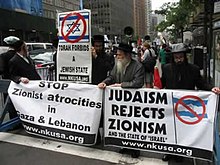
A few of the fringe groups of the anti-Zionists, with marginal ideology, does not recognize the legitimacy of the Israeli state. Among them are both the Orthodox (the Satmar Hasidism, Edah HaChareidis, Neturei Karta) and Reform (American Council for Judaism).[17][108]
In addition, according to some contemporary scholars, Religious Zionism stands at least outside of Rabbinic Judaism or ever shoots off Judaism as such.[109][102]
Pressures of assimilation[edit]
Among the most striking differences between the Jewish movements in the 21st century is their response to pressures of assimilation, such as intermarriage between Jews and non-Jews.[110] Reform and Reconstructionist rabbis have been most accepting of intermarried couples, with some rabbis willing to officiate in mixed religious ceremonies, although most insist that children in such families be raised strictly Jewish. Conservative rabbis are not permitted to officiate in such marriages, but are supportive of couples when the non-Jewish partner wishes to convert to Judaism and raise children as Jewish.[111]
Crypto-Judaism[edit]
The secret adherence to Judaism while publicly professing to be of another faith; practitioners are referred to as "crypto-Jews" (origin from Greek kryptos – κρυπτός, 'hidden').[112] Nowadays, in whole, Crypto-Judausm movements are a historical phenomenon.
In the United States, Reform rabbi Jacques Cukierkorn is one of the leaders of the outreach to the descendants of those Crypto-Jews who wish to renew their ties with the Jewish people.[113][better source needed]
The Crypto-Jews subgroups are as follows:
Other ethnic movements[edit]
Beta Israel (Haymanot)[edit]
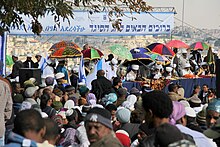
The Beta Israel (House of Israel), also known as Ethiopian Jews, are a Jewish community that developed in Ethiopia and lived there for centuries. Most of the Beta Israel emigrated to Israel in the late 20th century. They practiced Haymanot, a religion which is generally recognized as a non-Rabbinic form of Judaism (in Israel, they practice a mixture of Haymanot and Rabbinic Judaism). To the Beta Israel, the holiest book is the Orit (a word which means the "law"), and it consists of the Torah and the Books of Joshua, Judges and Ruth. Until the middle of the 20th century, the Beta Israel of Ethiopia were the only modern Jewish group which practiced a monastic tradition which the monks adhered to by living in monasteries which were separated from the Jewish villages.[114]
Crimean Karaites[edit]
The Crimean Karaites (a.k.a. Karaims) are an ethnicity which is derived from Turkic Karaim-speaking adherents of Karaite Judaism in Eastern Europe, especially in Crimea. They were probably Jewish by origin, but due to political pressure and other reasons, many of them began to claim that they were Turks, descendants of the Khazars. During the era when Crimea was a part of the Russian Empire, the Crimean Karaite leaders persuaded the Russian rulers to exempt Karaites from the anti-Semitic regulations which were imposed upon Jews. These Karaites were recognized as non-Jews during the Nazi occupation. Some of them even served in the SS. The ideology of de-Judaization and the revival of Tengrism were imbued with the works of the contemporary leaders of the Karaites in Crimea. While the members of several Karaite congregations were registered as Turks, some of them retained Jewish customs. In the 1990s, many Karaites emigrated to Israel, under the Law of Return.[115][116] The largest Karaite community has since then resided in Israel.
Igbo Jews[edit]
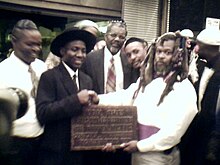
Igbo people of Nigeria who practice a form of Judaism are referred to as Igbo Jews. Judaism has been documented in parts of Nigeria since the precolonial period, from as early as the 1500s, but is not known to have been practiced in the Igbo region in precolonial times. Nowadays, up to 30,000 Igbos are practicing some form of Judaism.[117]
Subbotniks[edit]
The Subbotniks are a movement of Jews of Russian ethnic origin which split off from other Sabbatarians in the late 18th century. The majority of the Subbotniks practiced Rabbinic and Karaite Judaism, a minority of them practiced Spiritual Christianity.[118][119] Subbotnik families settled in the Holy Land which was then a part of the Ottoman Empire, in the 1880s, as part of the Zionist First Aliyah in order to escape oppression in the Russian Empire and later, most of them married other Jews. Their descendants included Israeli Jews such as Alexander Zaïd, Major-General Alik Ron,[120] and the mother of Ariel Sharon.[121]
20th/21st-century movements[edit]
20th-century movements[edit]
Additionally, a number of smaller groups have emerged:
A type of Judaism that is predominantly practiced in African communities, both inside and outside Africa (such as North America). It is theologically characterized by the selective acceptance of the Judaic faith (in some cases, such selective acceptance has historical circumstances), and the belief system of Black Judaism is significantly different from the belief system of the mainstream movements of Judaism. In addition, although Black Judaic communities adopt Judaic practices such as the celebration of Jewish holidays and the recital of Jewish prayers, some of them are generally not considered legitimate Jews by mainstream Jewish societies.[122][123]
Rather than a type, Judaism as practiced by the Abayudaya, in eastern Uganda and in Israel, is devout in keeping western halakha, especially as led by the Reform and Conservative movements, with whom most Abayudaya community members in Uganda affiliate.[124] Gershom Sizomu, the spiritual leader of the Abayudaya and Rosh Yeshiva, first native-born black rabbi in sub-Saharan Africa,[125] also the first chief rabbi of Uganda,[126] and since 2016 a Member of Uganda Parliament,[127] is a graduate of the American Jewish University in Los Angeles, California receiving ordination under the auspices of the Conservative movement in 2008. In June 2016, Rabbi Shlomo Riskin led a Beit Din that performed an Orthodox conversion for the Putti community in Uganda.[128][129]
Formed in the early 20th century by Alfred G. Moses and Morris Lichtenstein, Jewish Science was founded as a counterweight Jewish movement to Christian Science. Jewish Science sees God as a force or energy penetrating the reality of the Universe and emphasis is placed upon the role of affirmative prayer in personal healing and spiritual growth. The Society of Jewish Science in New York is the institutional arm of the movement regularly publishing The Interpreter, the movement's primary literary publication.[130]
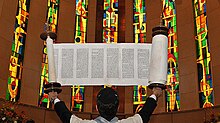
Founded by rabbi Mordecai Kaplan, the 1922 American split from Conservative Judaism that views Judaism as a progressively evolving civilization with focus on Jewish community.[11][131][132][133][106][134] The central organization is "Reconstructing Judaism". Assessments of its impact range from being recognized as the 4th major stream of Judaism[11][131][132][135][16] to described as a smaller movement.[136] As noted, Reconstructionism is a smaller movement, but its ideas significantly impacted Jewish life in the America.[15][137]
A nontheistic worldwide movement that emphasizes Jewish culture and history as the sources of Jewish identity. Originated in Detroit in 1963 with the founding figure, Reform rabbi Sherwin Wine, in 1969 was established the Society for Humanistic Judaism.[138][139]
The neo-Hasidic movement inspired by the counterculture of the 1960s and founded in the late 1960s in San Francisco (where opened the House of Love and Prayer), then in Israel, by a musician, Lubavich's Hasidic rabbi Shlomo Carlebach for the return of secular youth to the bosom of Orthodox Judaism. The movement has no organisational agenda and promotes Carlebach minyan, a song-filled form of Jewish worship.[140][141]
Partly syncretistic movement founded in the mid-1970s by ex-Lubavich's Hasidic rabbi Zalman Schachter-Shalomi and rooted in the counterculture of the 1960s and the Havurat Shalom group. The "Bnei ʻOr" (Songs of Light) in Philadelphia—the first Renewal community—later was established the ambrella organisation "ALEPH: the Alliance for Jewish Renewal". Its syncretism includes Kabbalah, neo-Hasidism, Reconstructionist Judaism, Western Buddhist meditation, Sufism, New Age, feminism, liberalism, and so on, tends to embrace the ecstatic worship style. Renewal congregations tend to be inclusive on the subject of who is a Jew and had avoided affiliation with any Jewish communities.[140][142]
The term is occasionally applied to describe either individuals or new congregations, especially congregations which were established in the US in 1984 by rabbi David Weiss Halivni, such as the Union for Traditional Judaism, located between the Conservative and Modern Orthodox.[143][144] While most scholars consider "Union for Traditional Judaism" (formerly Union for Traditional Conservative Judaism) as a new movement, some attribute it to the right wing of Conservative Judaism.[145]
A "New Age Judaism"[146] worldwide organisation established in 1984 by American rabbi Philip Berg, that popularizes Jewish mysticism among a universal audience.[147][148]
A Haredi sect formed in the 1980s by Israeli-Canadian rabbi Shlomo Helbrans, follows a strict version of halakha, including its own unique practices such as lengthy prayer sessions, arranged marriages between teenagers, and head-to-toe coverings for females.[149]
A movement founded by Avi Weiss in the late 1990s in US, with its own schools for religious ordination, both for men (Yeshivat Chovevei Torah) and women (Yeshivat Maharat). The movement declarates liberal, or inclusive Orthodoxy with women's ordination, full accepting LGBT members, and reducing stringent rules for conversion.[150]
A controversial ultra-Orthodox group with a Jewish burqa-style covering of a woman's entire body, including a veil covering the face.[151] Also known as the "Taliban Women" and the "Taliban Mothers" (נשות הטאליבן).[152]
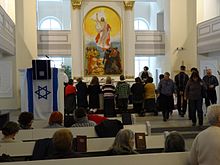
Made up of followers who seek to combine parts of Rabbinic Judaism with a belief in Jesus as the Messiah and other Jewish Christian and western Christian beliefs.[153][154] It is not regarded as Judaism by the major movements of Judaism, and it is considered a form of Protestant Christianity.[note 1] People who had become Messianic Jews as, in fact, Christians were not therefore eligible for Aliyah under the Law of Return.[156] "Scholars are divided as to whether to call Messianic Judaism a Christian or Jewish Sect."[157]
Remark: Baal teshuva movement—a description of the return of secular Jews to religious Judaism and involved with all the Jewish movements.
Trans- and post-denominational Judaism[edit]
Already in the 1980s, 20–30 percent of members of the largest American Jewish communities, such as of New York City or Miami, rejected a denominational label.[158] And "Israeli Democracy Index" commissioned in 2013 by the Israel Democracy Institute found that the two thirds of respondents said they felt no connection to any denomination, or declined to respond.[159]
The very idea of Jewish denominationalism is contested by some Jews and Jewish non-denominational organisations, which consider themselves to be "trans-denominational" or "post-denominational".[160][142][161][162][163] The term "trans-denominational" also applied to describe new movements located on the religious continuum between some major streams, as an instance, Conservadox (Union for Traditional Judaism).[143][144]
A variety of new Jewish organisations are emerging that lack such affiliations:
- Havurah movement is the number of small egalitarian experimental spiritual groups (first in 1960 in California) for prayer as autonomous alternatives to Jewish movements. Most notable of them is the Havurat Shalom in Somerville, Massachusetts;[142]
- Independent minyan movement is a lay-led Jewish worship and study community that has developed independently of established denominational and synagogue structures and combines halakha with egalitarianism;[164]
- International Federation of Rabbis (IFR), a non-denominational rabbinical organization for rabbis of all movements and backgrounds;[162]
- Some Jewish day schools lack affiliation with any one movement;[165][162]
- There are several seminaries which are not controlled by a denomination (see List of rabbinical schools § Non-denominational and Rabbi § Seminaries unaffiliated with main denominations):
- Academy for Jewish Religion (California) (AJRCA) is a transdenominational seminary based in Los Angeles, California. It draws faculty and leadership from all denominations of Judaism. It has programs for rabbis, cantors, chaplains, community leadership and Clinical Pastoral Education (CPE);[162]
- Academy for Jewish Religion (New York) (AJR) is a transdenominational seminary in Yonkers, NY, that trains rabbis and cantors and also offers Master's Program in Jewish Studies;[citation needed]
- Hebrew College, a seminary in Newton Centre, Massachusetts, near Boston;[162]
- Hebrew Seminary in Skokie, Illinois[citation needed]
- Other smaller, less traditional institutions include:[166]
- Rabbinical Seminary International, Jewish Spiritual Leaders Institute, Pluralistic Rabbinical Seminary, Rimmon Rabbinical School
- Mesifta Adath Wolkowisk aimed at community professionals with significant knowledge and experience.
Organizations such as these believe that the formal divisions that have arisen among the "denominations" in contemporary Jewish history are unnecessarily divisive, as well as religiously and intellectually simplistic. According to Rachel Rosenthal, "the post-denominational Jew refuses to be labeled or categorized in a religion that thrives on stereotypes. He has seen what the institutional branches of Judaism have to offer and believes that a better Judaism can be created."[167] Such Jews might, out of necessity, affiliate with a synagogue associated with a particular movement, but their own personal Jewish ideology is often shaped by a variety of influences from more than one denomination.
Bnei Noah[edit]
Noahidism, Noahides, or Bnei Noah (Hebrew: בני נח, "Sons of Noah") is a new religious movement which is based upon the Seven Laws of Noah. Historically, the Hebrew term Bnei Noah has been applied to all non-Jews because Jews believe that they are the descendants of Noah.[168] Nowadays, however, it is specifically used to refer to those "Righteous Gentiles" who observe the Seven Laws of Noah. According to Jewish law, non-Jews (Gentiles) are not obligated to convert to Judaism, but they are required to observe the Seven Laws of Noah in order to be assured that they will have a place in the World to Come (Olam Ha-Ba), the final reward of the righteous. The modern Noahide movement was founded in the 1990s by Orthodox rabbis from Israel (mainly tied Hasidic and Zionist).[169][170]
List of contemporary movements[edit]
- Orthodox Judaism
- Haredi Judaism (ultra-Orthodox)
- Hasidic Judaism
- Misnagdim (Lita'im, Lithuanian)
- Sephardic Haredim
- Dor Daim
- Other Haredim
- Modern Orthodox Judaism
- Haredi Judaism (ultra-Orthodox)
- Conservative Judaism (Masorti)
- Reform Judaism
- Other Rabbinic
- Non-Rabbinic
See also[edit]
- Genetic studies on Jews
- Groups claiming affiliation with Israelites
- Jewish diaspora
- Jewish prayer
- Jewish schisms
- Jewish views on religious pluralism
- List of religious organizations#Jewish organizations
- Who is a Jew?
Notes[edit]
- ^ "Messianic Judaism is a Protestant movement that emerged in the last half of the 20th century among believers who were ethnically Jewish but had adopted an Evangelical Christian faith… By the 1960s, a new effort to create a culturally Jewish Protestant Christianity emerged among individuals who began to call themselves Messianic Jews."[155]
References[edit]
- ^ a b Blau, Joseph Leon (1966). Modern Varieties of Judaism. New York: Columbia University Press. ISBN 0-23108-668-7.
- ^ a b c Tabory, Ephraim (2004) [1990]. "Reform and Conservative Judaism in Israel". In Goldscheider, Calvin; Neusner, Jacob (eds.). Social Foundations of Judaism (Reprint ed.). Eugene, Or: Wipf and Stock Publ. pp. 240–258. ISBN 1-59244-943-3.
- ^ a b c d Tabory, Ephraim (2004). "The Israel Reform and Conservative Movements and the Marker for the Liberal Judaism". In Rebhum, Uzi; Waxman, Chaim I. (eds.). Jews in Israel: Contemporary Social and Cultural Patterns. Brandeis University Press. pp. 285–314.
- ^ Deshen, Liebman & Shokeid 2017, Ch. 18 "Americans in the Israeli Reform and Conservative Denominations".
- ^ a b c Beit-Hallahmi, Benjamin (2011). "Jewish Religious Life in State of Israel". In Berlin, Adele (ed.). The Oxford Dictionary of the Jewish Religion (2nd ed.). Oxford; New York: Oxford University Press. pp. 385–387. ISBN 978-0-19-975927-9.
- ^ Deshen, Liebman & Shokeid 2017, pp. 33–62, Ch. 3 "Demensions of Jewish Religiosity".
- ^ a b Sarna, Jonathan D. (2004). American Judaism: A History. New Haven, Conn: Yale University Press. pp. xix–xx notes the "newfound popularity" of the term "denomination". ISBN 9780300129106.
- ^ a b Philipson, David (1907). The Reform Movement in Judaism. London; New York: Macmillan. Archived from the original on 2009-06-16.
- ^ a b Sklare, Marshall (1955). Conservative Judaism: An American Religious Movement. Glencoe, Il: The Free Press. ISBN 0819144800.
- ^ Rudavsky, David (1979) [1967]. Modern Jewish Religious Movements: A History of Emancipation and Abjustment (3rd rev. ed.). New York: Behrman House. ISBN 0-87441-286-2.
- ^ a b c d e f Neusner, Jacob, ed. (1975). The Sectors of American Judaism: Reform, Orthodoxy, Conservatism, and Reconstructionism. Understanding American Judaism: Toward the Description of a Modern Religion, vol. 2. New York: KTAV Publ. House. ISBN 0870682792.
- ^ Cohen, Arthur A.; Mendes-Flohr, Paul, eds. (2009) [1987]. 20th Century Jewish Religious Thought: Original Essays on Critical Concepts, Movements, and Beliefs. Philadelphia, Pa: JPS: The Jewish Publication Society. ISBN 978-0-8276-0892-4.
- ^ a b Meyer, Michael A. (1988). Response to Modernity: A History of the Reform Movement in Judaism. New York: Oxford University Press. ISBN 9780195051674.
- ^ Mittleman, Alan (1993). "Modern Jewish Religious Movements". In Wertheimer, Jack (ed.). The Modern Jewish Experience: A Reader's Guide. New York; London: NYU Press. pp. 169–180. ISBN 0-8147-9261-8.
- ^ a b c d e Karesh, Sara E.; Hurvitz, Mitchell M. (2005). "Introduction: Judaism". Encyclopedia of Judaism. Encyclopedia of World Religions. J. Gordon Melton, Series Editor. New York: Facts On File. pp. xiii–xxii. ISBN 0-8160-5457-6.
- ^ a b c d e Mendes-Flohr, Paul (2005). "Judaism". In Riggs, Thomas (ed.). Worldmark Encyclopedia of Religious Practices. Vol. 1. Farmington Hills, Mi: Thomson Gale. ISBN 9780787666118 – via Encyclopedia.com.
- ^ a b c d e f g Jacobs, Louis (2007). "Judaism". In Berenbaum, Michael; Skolnik, Fred (eds.). Encyclopaedia Judaica. Vol. 11 (2nd ed.). Detroit: Macmillan Reference. ISBN 978-0-02-866097-4 – via Encyclopedia.com.
- ^ a b c Elazar, Daniel J.; Geffen, Rela Mintz (2012). The Conservative Movement in Judaism: Dilemmas and Opportunities. Albany, NY: SUNY Press. ISBN 9780791492024.
- ^ Wertheimer, Jack (1991). "Recent Trends in American Judaism". In Neusner, Jacob (ed.). An Introduction to Judaism: A Textbook and Reader. Louisville, Kentucky: Westminster/John Knox Press. pp. 85–116. ISBN 0-664-25348-2.
- ^ Wertheimer, Jack (2018). The New American Judaism: How Jews Practice Their Religion Today. Princeton, NJ; Oxford: Princeton University Press. ISBN 978-0-691-18129-5.
- ^ Deshen, Shlomo; Liebman, Charles S.; Shokeid, Moshe, eds. (2017) [1995]. Israeli Judaism: The Sociology of Religion in Israel. Studies of Israeli Society, 7 (Reprint ed.). London; New York: Routledge. ISBN 978-1-56000-178-2.
- ^ Lazerwitz, Bernard Melvin; Winter, J. Alan; Dashefsky, Arnold; Tabory, Ephram (1998). Jewish Choices: American Jewish Denominationalism. SUNY series in American Jewish Society in the 1990s. Albany, NY: SUNY Press. ISBN 978-0-7914-3581-6.
- ^ Ferziger, Adam S. (2012). Jewish Denominations — Addressing the Challenges of Modernity. Jerusalem: Hebrew University of Jerusalem, Melton Institute. ISBN 978-606-072-000-3.
- ^ Rebhum, Uzi (2016). Jews and the American Religious Landscape. New York: Columbia University Press. ISBN 9780231178266.[permanent dead link]
- ^ Raphael, Marc Lee (1984). Profiles in American Judaism: the Reform, Conservative, Orthodox, and Reconstructionist traditions in historical perspective. San Francisco, Ca: Harper & Row. ISBN 0-06066801-6.
- ^ Wertheimer 2018, p. 103.
- ^ Neusner 1975, "The Orthodox stream".
- ^ a b Jacobs, Louis (2003). "Liberal Judaism". A Concise Companion to the Jewish Religion (Online Version). Oxford University Press. ISBN 9780191726446.
- ^ Neusner 1975, "Orthodox sectarians".
- ^ a b Ferziger, Adam S. (2015). Beyond Sectarianism: The Realignment of American Orthodox Judaism. Detroit, Mi: Wayne State University Press. ISBN 978-0-8143-3953-4.
- ^ a b Jacobs, Louis (2003). "Orthodox Judaism". A Concise Companion to the Jewish Religion (Online Version). Oxford University Press. ISBN 9780191726446.
- ^ a b c Schiffman, Lawrence H. (2003). Bloomberg, Jon; Kapustin, Samuel (eds.). Understanding Second Temple and Rabbinic Judaism. Jersey, NJ: KTAV Publ. House. ISBN 9780881258134.
- ^ a b Grabbe, Lester L. (2010). An Introduction to Second Temple Judaism: History and Religion of the Jews in the Time of Nehemiah, the Maccabees, Hillel, and Jesus. London; New York: T&T Clark International. ISBN 978-0-567-05161-5.
- ^ Neusner, Jacob (2002). Rabbinic Judaism: Theological System. Boston; Leiden: Brill Academic Publ. ISBN 0-391-04143-6.
- ^ "Rabbinic Judaism". Encyclopædia Britannica Online. Retrieved 2020-11-07.
- ^ Sela, Shulamit (1994). "The Head of the Rabbanite, Karaite and Samaritan Jews: On the History of a Title". Bulletin of the School of Oriental & African Studies. 57 (2). University of London: 255–267. doi:10.1017/S0041977X00024848. S2CID 162698361.
- ^
 This article incorporates text from a publication now in the public domain: Kohler, Kaufmann; Harkavy, Abraham de (1901–1906). "Karaites and Karaism". In Singer, Isidore; et al. (eds.). The Jewish Encyclopedia. New York: Funk & Wagnalls.
This article incorporates text from a publication now in the public domain: Kohler, Kaufmann; Harkavy, Abraham de (1901–1906). "Karaites and Karaism". In Singer, Isidore; et al. (eds.). The Jewish Encyclopedia. New York: Funk & Wagnalls.{{cite encyclopedia}}: CS1 maint: multiple names: authors list (link) - ^ Yaron, Y.; Pessah, Joe; Qanaï, Avraham; El-Gamil, Yosef (2003). An Introduction to Karaite Judaism: History, Theology, Practice and Culture. Albany, NY: Qirqisani Center. ISBN 978-0-9700775-4-7.
- ^ Himelstein, Shmuel (2011). "Chief Rabbinate". In Berlin, Adele (ed.). The Oxford Dictionary of the Jewish Religion (2nd ed.). Oxford; New York: Oxford University Press. p. 166. ISBN 978-0-19-975927-9.
- ^ a b c Rudavsky 1979, pp. 50–78.
- ^ a b Dobrinsky, Herbert C. (1988). A treasury of Sephardic laws and customs: the ritual practices of Syrian, Moroccan, Judeo-Spanish and Spanish and Portuguese Jews of North America (Rev. ed.). Hoboken, NJ; New York: KTAV Publ. House; Yeshiva University Press. ISBN 0-88125-031-7.
- ^ Zohar, Zion, ed. (2005). Sephardic and Mizrahi Jewry: From the Golden Age of Spain to Modern Times. New York; London: NYU Press. ISBN 0-8147-9705-9.
- ^ a b Weiner, Rebecca. "Judaism: Sephardim". Jewish Virtual Library. A Project of AICE. Retrieved 2020-11-07.
- ^ Meyer 1988, pp. 232–235.
- ^ a b Chryssides, George (2006). "Reform Judaism". In Clarke, Peter B. (ed.). Encyclopedia of new religious movements. London; New York: Routledge. pp. 525–526. ISBN 9-78-0-415-26707-6.
- ^ Ferziger, Adam S. (Spring 2001). "Between 'Ashkenazi' and Sepharad: An Early Modern German Rabbinic Response to Religious Pluralism in the Spanish-Portuguese Community". Studia Rosenthaliana. 35 (1). Amsterdam University Press: 7–22. JSTOR 41482436.
- ^ Deshen, Liebman & Shokeid 2017, Part 5 "The Sephardic Pattern".
- ^ Simon, Reeva; Laskier, Michael; Reguer, Sara, eds. (2002). The Jews of the Middle East and North Africa In Modern Times. New York: Columbia University Press, s.v. Ch. 8 and 21.
- ^ Berenbaum, Michael; Skolnik, Fred, eds. (2007). "Shas". Encyclopaedia Judaica. Vol. 18 (2nd ed.). Detroit: Macmillan Reference. pp. 419–420. ISBN 978-0-02-866097-4.
- ^ Rudavsky 1979, pp. 116–155.
- ^ a b Fishman, David E. (1993). "Hasidism and Its Opponents". In Wertheimer, Jack (ed.). The Modern Jewish Experience: A Reader's Guide. New York; London: NYU Press. pp. 151–157. ISBN 0-8147-9261-8.
- ^ Jacobs, Louis (2003). "Hasidism". A Concise Companion to the Jewish Religion (Online Version). Oxford University Press. ISBN 9780191726446.
- ^ Assaf, David. "Hasidism: Historical Overview". YIVO Encyclopedia of Jews in Eastern Europe. YIVO Institute for Jewish Research. Retrieved 2020-11-25.
- ^ a b [Telushkin, Joseph]. "Orthodox Judaism: Hasidim and Mitnagdim". Jewish Virtual Library. A Project of AICE. Retrieved 2023-06-16.
- ^ Rudavsky 1979, pp. 135–139.
- ^ Nadler, Allan (1997). The Faith of the Mithnagdim: Rabbinic Responses to Hasidic Rapture. Johns Hopkins Jewish studies. Baltimore, Md: Johns Hopkins University Press. ISBN 9780801861826.
- ^ Nadler, Allan. "Misnagdim". YIVO Encyclopedia of Jews in Eastern Europe. YIVO Institute for Jewish Research. Retrieved 2020-11-02.
- ^ Jacobs, Louis (2003). "Mitnaggedim". A Concise Companion to the Jewish Religion (Online Version). Oxford University Press. ISBN 9780191726446.
- ^ Karz, Dov (1977). The Musar Movement: Its History, Leading Personalities, and Doctrines. Vol. 1. Translated by Leonard Oschry. Tel Aviv: Orly Press.
- ^ Bacon, Gershon C. (2005). "Musar Movement". In Jones, Lindsay (ed.). Encyclopedia of Religion: 15-volume Set (2nd ed.). Farmington Hills, Mi: Macmillan Reference USA – via Encyclopedia.com.
- ^ Jacobs, Louis (2003). "Musar Movement". A Concise Companion to the Jewish Religion (Online Version). Oxford University Press. ISBN 9780191726446.
- ^ Mirsky, Yehudah. "Musar Movement". YIVO Encyclopedia of Jews in Eastern Europe. YIVO Institute for Jewish Research. Retrieved 2023-06-18.
- ^ Lazerwitz et al. 1998, pp. 15–24.
- ^ Rudavsky 1979, pp. 98–115.
- ^ Rudavsky 1979, pp. 218–270, 367–402.
- ^ Raphael 1984, pp. 125–176.
- ^ Brown, Benjamin (2003) [2000]. "Orthodox Judaism". In Neusner, Jacob; Avery-Peck, Alan J. (eds.). The Blackwell Companion to Judaism (Reprint ed.). Malden, Mass: Blackwell Publ. pp. 311–333. ISBN 1-57718-058-5.
- ^ a b Berenbaum, Michael; Skolnik, Fred, eds. (2007). "Orthodoxy". Encyclopaedia Judaica. Vol. 12 (2nd ed.). Detroit: Macmillan Reference. pp. 1486–93. ISBN 978-0-02-866097-4.
- ^ Silber, Michael K. "Orthodoxy". YIVO Encyclopedia of Jews in Eastern Europe. YIVO Institute for Jewish Research. Retrieved 2012-08-15.
- ^ Ellenson, David Henry (1990). Rabbi Esriel Hildesheimer and the creation of a modern Jewish orthodoxy. Judaic studies series. Tuscaloosa, Al: University of Alabama Press. ISBN 0-8173-0485-1.
- ^ a b Wertheimer 2018, pp. 67–100, 143–159.
- ^ Schweid, Eliezer (1984–1985). "Two Neo-Orthodox Responses to Secularization. Part I: Samson Raphael Hirch" (PDF). Immanuel (19). Translated by Yohanan Eldad: 107–117. Archived from the original (PDF) on 2018-03-05. Retrieved 2021-01-03.
- ^ Liberles, Robert (1985). Conflict in Social Context: The Resurgence of Orthodox Judaism in Frankfurt am Main, 1838–1877. Contributions to the Study of Religion, 13. Westport, Conn.: Greenwood Press. ISSN 0196-7053.
- ^ Bernstein, Saul (1997). The Orthodox Union Story: A Centenary Portrayal. Northvale, NJ: Jason Aronson. ISBN 9780765799531.
- ^ Rudavsky 1979, pp. 156–185, 285–316.
- ^ Raphael 1984, pp. 1–78.
- ^ Goldscheider, Calvin; Zuckerman, Alan (2004) [1990]. "The Judaic Reformation as a Sociopolitical Process". In Goldscheider, Calvin; Neusner, Jacob (eds.). Social Foundations of Judaism (Reprint ed.). Eugene, Or: Wipf and Stock Publ. pp. 83–93. ISBN 1-59244-943-3.
- ^ Kaplan, Dana Evan (2003) [2000]. "Reform Judaism". In Neusner, Jacob; Avery-Peck, Alan J. (eds.). The Blackwell Companion to Judaism (Reprint ed.). Malden, Mass: Blackwell Publ. pp. 291–310. ISBN 1-57718-058-5.
- ^ Kaplan, Dana Evan (2007). "Reform Judaism". In Berenbaum, Michael; Skolnik, Fred (eds.). Encyclopaedia Judaica. Vol. 17 (2nd ed.). Detroit: Macmillan Reference. ISBN 978-0-02-866097-4.
- ^ Karesh, Sara E.; Hurvitz, Mitchell M. (2005). "Reform Judaism". Encyclopedia of Judaism. Encyclopedia of World Religions. J. Gordon Melton, Series Editor. New York: Facts On File. pp. 419–422. ISBN 0-8160-5457-6.
- ^ Neusner, Jacob, ed. (1993). The Reformation of Reform Judaism. Judaism in Cold War America, 1945–1990, vol. 6. New York; London: Garland Publ. ISBN 9780815300762.
- ^ Kaplan, Dana Evan (2013). The New Reform Judaism: Challenges and Reflections. Lincoln, Na; Philadelphia, Pa: University of Nebraska Press; Jewish Publication Society. ISBN 9781461940500.
- ^ a b Wertheimer, Jack, ed. (2002). Jews in the Center: Conservative Synagogues and Their Members. New Brunswick, NJ: Rutgers University Press. p. 68. ISBN 0-8135-2821-6.
- ^ Wertheimer 2018, pp. 103–120.
- ^ Rudavsky 1979, pp. 186–217.
- ^ Wertheimer 2018, pp. 121–142.
- ^ Rudavsky 1979, pp. 317–346.
- ^ Raphael 1984, pp. 79–124.
- ^ Gillman, Neil (1993). Conservative Judaism: The New Century. New York: Behrman House. ISBN 0-87441-547-0.
- ^ Gordis, Daniel (2003) [2000]. "Conservative Judaism: The Struggle between Ideology and Popularity". In Neusner, Jacob; Avery-Peck, Alan J. (eds.). The Blackwell Companion to Judaism (Reprint ed.). Malden, Mass: Blackwell Publ. pp. 334–353. ISBN 1-57718-058-5.
- ^ Silvan, Gabriel (2011). "Neology". In Berlin, Adele (ed.). The Oxford Dictionary of the Jewish Religion (2nd ed.). Oxford; New York: Oxford University Press. p. 533. ISBN 978-0-19-975927-9.
- ^ a b Syme, Daniel B. (1988). The Jewish Home: A Guide for Jewish Living. URJ Press. ISBN 0874419883.
- ^ a b Donin, Hayim Halevy (1972). To Be a Jew: A Guide to Jewish Observance in Contemporary Life. Basic Books. ISBN 1541674022.
- ^ Roden, Claudia (1996). The Book of Jewish Food: An Odyssey from Samarkand to New York. Knopf. ISBN 0-394-53258-9.
- ^ Johnson, Paul (1987). A History of the Jews. Harper & Row. ISBN 0-06-091533-1.
- ^ Hazony, Yoram (2000). The Jewish State: The Struggle for Israel's Soul. Basic Books. ISBN 0-465-02966-3.
- ^ Kushner, Lawrence (2001). Jewish Spirituality: A Brief Introduction for Christians. Jewish Lights Publishing. ISBN 1580231500.
- ^ Morinis, Alan (2007). Everyday Holiness: The Jewish Spiritual Path of Mussar. Trumpeter. ISBN 1590306090.
- ^ Herberg, Will (1983). Protestant, Catholic, Jew: An Essay in American Religious Sociology. Chicago: University of Chicago Press (reprint). ISBN 0-226-32734-5. OCLC 9686985.
- ^ Ticker, Jay (1975). The Centrality of Sacrifices as an Answer to Reform in the Thought of Zvi Hirsch Kalischer. Working Papers in Yiddish and East European Studies, vol. 15. New York: YIVO Institute for Jewish Research.
- ^ a b c d Halpern, Ben (2004) [1990]. "The Rise and Reception of Zionism in the Nineteenth Century". In Goldscheider, Calvin; Neusner, Jacob (eds.). Social Foundations of Judaism (Reprint ed.). Eugene, Or: Wipf and Stock Publ. pp. 94–113. ISBN 1-59244-943-3.
- ^ a b Aran, Gideon (2004) [1990]. "From Religious Zionism to Zionist Religion". In Goldscheider, Calvin; Neusner, Jacob (eds.). Social Foundations of Judaism (Reprint ed.). Eugene, Or: Wipf and Stock Publ. pp. 259–282. ISBN 1-59244-943-3.
- ^ a b Ravitzky, Aviezer (1996) [1993]. Messianism, Zionism, and Jewish Religious Radicalism. Translated by Michael Swirsky and Jonathan Chipman. Chicago, Mi: University of Chicago Press. ISBN 0-226-70577-3.
- ^ Deshen, Liebman & Shokeid 2017, Part 4 "Nationalist Orthodoxy".
- ^ Waxman, Chaim I., ed. (2008). Religious Zionism Post Disengagement: Future Directions. Orthodox Forum Series. New York: Michael Scharf Publ. Trust, Yeshiva University Press. ISBN 978-1-60280-022-9.
- ^ a b Karesh, Sara E.; Hurvitz, Mitchell M. (2005). "Reconstructionist Judaism". Encyclopedia of Judaism. Encyclopedia of World Religions. J. Gordon Melton, Series Editor. New York: Facts On File. pp. 416–418. ISBN 0-8160-5457-6.
- ^ Deshen, Liebman & Shokeid 2017, Ch. 10 "Religious Kibbutzim: Judaism and Modernization".
- ^ a b Ravitzky, Aviezer (1999). "Ultra-Orthodox and Anti-Zionist". In Jacob Neusner; et al. (eds.). The Encyclopedia of Judaism. Vol. 3. Leiden; New York: Brill; Continuum. ISBN 9780826411778 – via Myjewishlearning.com.
- ^ Neusner, Jacob (1991). "Judaism outside of Rabbinic Judaism: Zionism". An Introduction to Judaism: A Textbook and Reader. Louisville, Kentucky: Westminster/John Knox Press. pp. 309–322. ISBN 0-664-25348-2.
- ^ Tobin, Gary A.; G. Simon, Katherine (1999). Rabbis Talk About Intermarriage. Institute for Jewish and Community Research. ISBN 1-893671-00-3. OCLC 44759291.
- ^ Bloom, Mark; et al. (2004). A Place In The Tent: Intermarriage And Conservative Judaism. Eks Publ. ISBN 0-939144-46-8. OCLC 179259677.
- ^ Berlin, Adele, ed. (2011). "Cripto-Jews". The Oxford Dictionary of the Jewish Religion (2nd ed.). Oxford; New York: Oxford University Press. pp. 195–96. ISBN 978-0-19-975927-9.
- ^ "Are American Jews the New Secret Jews? Interview with Rabbi Jacques Cukierkorn". Chicago Jewish Cafe. 2018-10-03. Archived from the original on 2021-12-21. Retrieved 2018-10-08.
- ^ "Beta Israel". Encyclopædia Britannica Online. Retrieved 2020-11-07.
- ^ Kizilov, Mikhail. "Karaites and Karaism: Recent Developments". Religion and Democracy: An Axchange of Experiences between East and West. The CESNUR 2003 International Conference organized by CESNUR, Center for Religious Studies and Research at Vilnius University, and New Religions Research and Information Center. Vilnius, Lithuania, April 9–12, 2003. CESNUR.
- ^ Moroz, Eugeny (2004). "От иудаизма к тенгрианству. Ещё раз о духовных поисках современных крымчаков и крымских караимов»" [From Judaism to Tengrism. Once again about the spiritual quest of the contemporary Krymchaks and Crimean Karaites]. Народ Книги в мире книг [People of the Book in the world of books] (in Russian) (52): 1–6.
- ^ Bruder, Edith (2008). The Black Jews of Africa: History, Religion, Identity. Oxford; New York: Oxford University Press. ISBN 978-0-19-533356-5. p. 143.
- ^
 This article incorporates text from a publication now in the public domain: Rosenthal, Herman; Hurwitz, S. (1901–1906). "Subbotniki ("Sabbatarians")". In Singer, Isidore; et al. (eds.). The Jewish Encyclopedia. New York: Funk & Wagnalls.
This article incorporates text from a publication now in the public domain: Rosenthal, Herman; Hurwitz, S. (1901–1906). "Subbotniki ("Sabbatarians")". In Singer, Isidore; et al. (eds.). The Jewish Encyclopedia. New York: Funk & Wagnalls.
- ^ Dynner, Glenn (2011). Holy Dissent: Jewish and Christian Mystics in Eastern Europe. Detroit, Mi: Wayne State University Press. pp. 358–9. ISBN 9780814335970. Archived from the original on 2023-02-10.
- ^ Weiss, Ruchama; Brackman, Levi (December 9, 2010). "Russia's Subbotnik Jews get rabbi". Israel Jewish Scene. Archived from the original on 2021-05-01. Retrieved 2015-08-22.
- ^ Eichner, Itamar (March 11, 2014). "Subbotnik Jews to resume aliyah". Israel Jewish Scene. Archived from the original on 2014-04-09. Retrieved 2014-04-09.
- ^ Bruder 2008.
- ^ Landing, James E. (2002). Black Judaism: Story of an American Movement. Durham, NC: Carolina Academic Press. ISBN 978-0-89089-820-8.
- ^ Maltz, Judy (2020-01-05). "In First, a Ugandan-Jewish Wedding in Israel". Haaretz. Retrieved 2020-01-07.
- ^ "Over 250 Africans convert to Judaism in Uganda", Jerusalem Post, July 16, 2008[permanent dead link]
- ^ http://fr.jpost.com/servlet/Satellite?cid=1215331079553&pagename=JPost/JPArticle/ShowFull[permanent dead link]
- ^ Kestenbaum, Sam (2016-02-27) [last updated April 10, 2018]. "Rabbi From Tiny Ugandan Jewish Community Wins Seat in Parliament". Haaretz. Archived from the original on 2021-01-26.
- ^ The Abayuday:Judaism Emerging, A Spiritual Journey Into Africa, by Menachem Kuchar.
- ^ The Committee To Save Ugandan Jewry - A First Hand Account of The History of the Abayudaya Archived 2007-12-11 at the Wayback Machine
- ^ Umansky, Ellen M. (2005). From Christian Science to Jewish Science: Spiritual Healing and American Jews. New York: Oxford University Press. ISBN 0-19-504400-2.
- ^ a b Rudavsky 1979, pp. 347–366.
- ^ a b Raphael 1984, pp. 177–194.
- ^ Neusner, Jacob, ed. (1993). Conserving Conservative Judaism: Reconstructionist Judaism. Judaism in Cold War America, 1945–1990, vol. 7. New York; London: Garland Publ. ISBN 9780815300786.
- ^ Alpert, Rebecca (2011). "Judaism, Reconstructionist". The Cambridge Dictionary of Judaism and Jewish Culture. Cambridge University Press. p. 346.
- ^ Mittleman 1993, p. 169.
- ^ Niebuhr, Gustav (January 18, 1997). "A Jewish Movement Takes Stock of Itself at Age 40". The New York Times.
- ^ Liebman, Charles S. (1970). "Reconstructionism in American Jewish Life" (PDF). American Jewish Year Book: 3–99.
- ^ Karesh, Sara E.; Hurvitz, Mitchell M. (2005). "Humanistic Judaism". Encyclopedia of Judaism. Encyclopedia of World Religions. J. Gordon Melton, Series Editor. New York: Facts On File. p. 221. ISBN 0-8160-5457-6.
- ^ Cohn-Sherbok, Dan (2006). "Humanistic Judaism". In Clarke, Peter B. (ed.). Encyclopedia of new religious movements. London; New York: Routledge. pp. 288–289. ISBN 9-78-0-415-26707-6.
- ^ a b Magid, Shaul (2005). "Jewish Renewal Movement" (PDF). In Jones, Lindsay (ed.). The Encyclopedia of Religion. Vol. 7 (2nd ed.). Farmington Hills, Mi: Macmillan Reference USA. pp. 4868–74. ISBN 0-02-865740-3.
- ^ Magid, Shaul (2013). American Post-Judaism: Identity and Renewal in a Postethnic Society. Religion in North America. Bloomington, In: Indiana University Press. pp. 233–239. ISBN 9780253008022.
- ^ a b c Magid 2013.
- ^ a b Ament, Jonathon (2004). The Union for Traditional Judaism: A Case Study of Contemporary Challenges to a New Religious Movement (PhD thesis). Waltham, Mass.: Department of Near Eastern and Jewish Studies, Brandeis University.
- ^ a b Michaelson, Jay (October 13, 2006). "Old Labels Feel Stiff for 'Flexidox'". The Jewish Daily Forward. Archived from the original on 2006-10-18.
- ^ Lazerwitz et al. 1998, p. 24.
- ^ Salkin, Jeffrey K. (2003) [2000]. "New Age Judaism". In Neusner, Jacob; Avery-Peck, Alan J. (eds.). The Blackwell Companion to Judaism (Reprint ed.). Malden, Mass: Blackwell Publ. pp. 354–370. ISBN 1-57718-058-5.
- ^ Puttick, Elizabeth (2006). "Kabbalah". In Clarke, Peter B. (ed.). Encyclopedia of new religious movements. London; New York: Routledge. pp. 322–323. ISBN 9-78-0-415-26707-6.
- ^ Myers, Jody Elizabeth (2007). Kabbalah and the spiritual quest: the Kabbalah Centre in America. Westport, Conn: Praeger. ISBN 978-0-275-98940-8.
- ^ Fogelman, Shay (March 9, 2012). "Lev Tahor: Pure as the driven snow, or hearts of darkness?". Haaretz. Archived from the original on 2014-05-17. Retrieved 2014-05-29.
- ^ Ginsberg, Johanna (August 16, 2017). "Closing A Chapter On 'Open Orthodoxy'". The New York Jewish Week. Retrieved 2020-12-30.
- ^ "A Jewish Movement to Shroud the Female Form". NPR. March 17, 2008. Archived from the original on July 29, 2018. Retrieved February 27, 2019.
- ^ Novick, Akiva (February 6, 2011). "'Taliban women': A cover story". Ynetnews.com.
- ^ Feher, Shoshana (1998). Passing over Easter: Constructing the Boundaries of Messianic Judaism. Walnut Creek, Ca: AltaMira Press. ISBN 9780761989523.
- ^ Cohn-Sherbok, Dan (2000). Messianic Judaism. London; New York: Continuum. ISBN 978-0-8264-5458-4.
- ^ Melton, J. Gordon, ed. (2005). "Messianic Judaism". Encyclopedia of Protestantism. Encyclopedia of World Religions. New York: Facts On File. p. 373. ISBN 0-8160-5456-8.
- ^ "Israeli Court Rules Jews for Jesus Cannot Automatically Be Citizens". The New York Times. December 27, 1989. Archived from the original on 2008-05-23. Retrieved 2010-05-07.
- ^ Foreman, Esther (2006). "Messianic Judaism". In Clarke, Peter B. (ed.). Encyclopedia of new religious movements. London; New York: Routledge. pp. 397–399. ISBN 9-78-0-415-26707-6. p. 399.
- ^ Wertheimer 1991, pp. 86–88.
- ^ Ettinger, Yair (June 11, 2013). "Poll: 7.1 Percent of Israeli Jews Define Themselves as Reform or Conservative". Haaretz. Retrieved 2023-06-26.
- ^ Ferziger 2012, Lesson 10. Beyond Denominationalism.
- ^ Heilman, Uriel (February 11, 2005). "Beyond Dogma". The Jerusalem Post.
- ^ a b c d e McHenry, Terry W. (2018). "Ch. 5.1.2 Judaism. Modern Religious Sects". Truth Versus Man'S Religious Systems. Xlibris US. ISBN 9781543470857.
- ^ Wertheimer 2018, pp. 160–180.
- ^ Salmon, Jackquelin L. (June 6, 2009). "New Judaism". The Washington Post.
- ^ Mendelsohn, Martha (August 22, 2002). "High School Without Labels". The Jewish Week.
- ^ Lobel, Andrea (2021). "A Different Path to Ordination". Tablet.
- ^ Rosenthal, Rachel (2006). "What's in a name?". Kedma (Winter).
- ^
 This article incorporates text from a publication now in the public domain: Singer, Isidore; Greenstone, Julius H. (1901–1906). "Noachian Laws". In Singer, Isidore; et al. (eds.). The Jewish Encyclopedia. New York: Funk & Wagnalls.
This article incorporates text from a publication now in the public domain: Singer, Isidore; Greenstone, Julius H. (1901–1906). "Noachian Laws". In Singer, Isidore; et al. (eds.). The Jewish Encyclopedia. New York: Funk & Wagnalls.
- ^ Feldman, Rachel Z. (October 8, 2017). "The Bnei Noah (Children of Noah)". World Religions and Spirituality Project. Archived from the original on 2020-01-21. Retrieved 2020-11-03.
- ^ Feldman, Rachel Z. (August 2018). "The Children of Noah: Has Messianic Zionism Created a New World Religion?" (PDF). Nova Religio: The Journal of Alternative and Emergent Religions. 22 (1): 115–128. doi:10.1525/nr.2018.22.1.115. S2CID 149940089 – via Project MUSE.
Further reading[edit]
- Neusner, Jacob; Avery-Peck, Alan J.; Green, William Scott, eds. (1999). The Encyclopedia of Judaism. Vol. 1–3. Leiden; New York: Brill; Continuum. ISBN 9789004105836.
- Skolnik, Fred, ed. (2007). Encyclopaedia Judaica. Vol. 1–22 (2nd rev. ed.). Farmington Hills, Mi: Macmillan Reference USA. ISBN 978-002-865-928-2.
External links[edit]
- Neusner, Jacob; et al. (eds.). Encyclopedia of Judaism Online.
- Emergence of Jewish Denominations (MyJewishLearning.com)
- Jewish World Today. Overview: State of the Denominations (MyJewishLearning.com)
- Jewing Movements - How Jewish movements will and have evolved
- Orthodox/Haredi
- Orthodox Judaism – The Orthodox Union
- Chabad-Lubavitch
- Rohr Jewish Learning Institute
- The Various Types of Orthodox Judaism Archived 2005-11-03 at the Wayback Machine
- Aish HaTorah
- Ohr Somayach
- Traditional/Conservadox
- Conservative
- The United Synagogue of Conservative Judaism
- Masorti (Conservative) Movement in Israel
- United Synagogue Youth
- Reform/Progressive
- The Union for Reform Judaism (USA)
- Reform Judaism (UK)
- Liberal Judaism (UK)
- World Union for Progressive Judaism (Israel)
- Reconstructionist
- Renewal
- Humanistic
- Karaite
